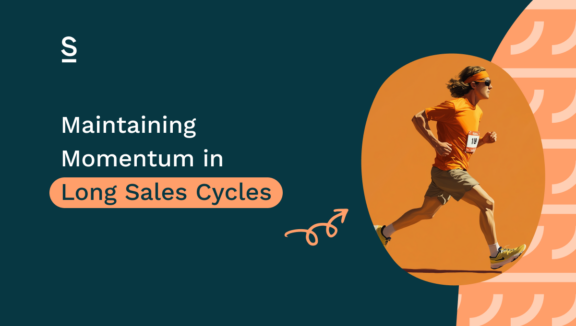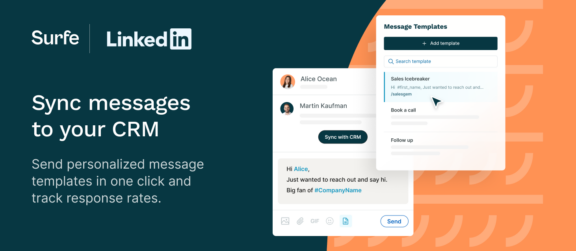How to Manage Long Sales Cycles Without Losing Momentum

Sales cycles are a marathon, not a sprint, especially when you’re working in complex industries like tech or software. Extended sales processes often feel like an uphill battle; and keeping up momentum, staying energized, and avoiding burnout can be the biggest challenge of any sales professional.
But if you get complacent, and take your foot off the pedal, the cost can be great. Because every interaction in the sales cycle builds toward that final close. Without a plan, long sales cycles can feel daunting, and the risk of losing steam is real.
So how can you stay productive and keep the prospect engaged throughout these extended timelines? Let’s dive in.
In this article, we’ll cover:
- Why do Long Sales Cycles Happen?
- How to Stay Engaged and Maintain Momentum
- Keeping Your Prospect Interested
Why Do Long Sales Cycles Happen?
Not all sales are created equal, and some naturally require more time to close due to various factors. Identifying the reason behind the prolonged process can help you better tackle a tough sales cycle.
Many long sales cycles happen because of the complexity involved. Products or services with a high price tag, intricate integrations, or those requiring input from multiple decision-makers tend to take more time for evaluation.
For example, in B2B sales, large-scale software implementations often need several rounds of approvals and demonstrations. One department might be sold on the product, but another needs reassurance about integration issues, which can delay the process.
Buyer Hesitation or Internal Delays
Buyers may need more time due to internal approval processes or hesitation. Risk aversion is common, especially when the investment is significant. Additionally, buyers may have competing priorities or require approval from other departments, such as finance or legal, adding layers of delay.
Take a scenario where a company is interested in a new enterprise-level solution. Even if the team responsible for implementation is excited, they might need to wait for the green light from senior leadership or the finance department, especially if new budgeting cycles are involved.
External Factors
External circumstances, such as economic conditions, industry shifts, or organizational restructuring, can also cause long delays in the sales cycle. A buyer may pause a decision due to end-of-year budgeting constraints, a sudden change in the company’s focus, or evolving regulatory issues that need attention before making a purchase.
How to Stay Engaged and Maintain Momentum
Understanding why long sales cycles happen is essential, but even more crucial is developing strategies to navigate them successfully. Let’s explore some practical ways to stay focused and ensure deals progress smoothly, despite the drawn-out timeline.
Set Milestones and Mini-Goals
Breaking the sales process into smaller, manageable phases can make a long cycle feel less overwhelming. Each phase should have clear goals for both you and the prospect, serving as checkpoints that keep the deal moving forward.
For instance, after the initial discovery call, set the objective to schedule a product demo within the next two weeks. From there, aim for another follow-up to discuss pricing or specific concerns within a month. These milestones create momentum by giving you and the prospect a roadmap to follow, helping you measure progress and stay engaged.
Regularly Check In Without Being Pushy
Regular follow-ups are key to maintaining momentum in a long sales cycle. However, it’s important to strike the right balance— being consistent without coming off as overbearing. A good approach is to set scheduled touch-points while offering value with each interaction.
Instead of just “checking in” to see where things stand, provide valuable insights like relevant case studies or industry updates. For example, you might say, “I wanted to share this recent report about market trends that directly impacts the challenges we discussed.” This keeps the conversation alive and positions you as a trusted partner rather than just another salesperson.
Stay Organized with CRM Tools
Keeping track of every interaction is crucial when navigating a long sales cycle. CRM tools are your best friend here, allowing you to document each conversation, note key decision-makers, and set reminders for follow-ups.
For example, logging every meeting and email exchange will help you create a clear timeline of the sales process. This ensures nothing falls through the cracks, and you’re always prepared for your next conversation.
Nurture the Relationship
The extended nature of a long sales cycle gives you a unique opportunity to build deeper relationships with key stakeholders. Use this time to establish trust and position yourself as a valuable resource.
Instead of always focusing on closing the deal, offer insights, share relevant educational content, or help them solve smaller problems that might arise. This approach not only strengthens your relationship but also demonstrates your commitment to their success beyond the immediate sale.

Keeping Your Prospect Interested
Now that you’re organized and staying on top of your follow-ups, the next step is to ensure the prospect remains engaged throughout the process.
Personalize Your Communication
Personalization is key when maintaining interest over an extended period. Tailor every interaction with tools like Surfe’s personalized message templates to address the prospect’s unique needs, concerns, and challenges. Generic follow-up emails won’t cut it in a long sales cycle; you need to demonstrate that you understand their business on a deeper level.
For example, when sending an update, reference specific conversations you’ve had or issues they’ve mentioned. This shows that you’re paying attention and keeping their goals at the forefront of your mind.
Provide Value at Every Step
The best way to keep a prospect engaged is to continually provide value. Share content that aligns with their specific challenges and goals, such as relevant case studies, industry reports, or even product updates.
Let’s say you’ve been discussing their need for better data analytics. You could share a new whitepaper on the future of data in their industry. This not only positions you as an expert but keeps the prospect thinking about your solution in the context of their ongoing challenges.
Address Objections Early
One common pitfall in long sales cycles is waiting too long to address objections. If a prospect has concerns about pricing, timing, or implementation, these objections need to be handled early to prevent delays later on.
For example, if pricing is a concern, offer flexible payment plans or discounts for early commitment. By proactively addressing these roadblocks, you reduce hesitation and keep the momentum moving toward a close.
Fueling Your Own Focus
Managing a long sales cycle can be mentally and emotionally draining. So, how do you maintain your own energy and focus without burning out? Here are a few strategies to stay productive while navigating these lengthy processes.
Work on Multiple Deals Simultaneously
One way to stay energized during a long sales cycle is to keep your pipeline full. Don’t put all your effort into one deal—balance your time by working on multiple opportunities.
For example, while you’re waiting for a decision from one prospect, you can be prospecting new clients, preparing demos, or advancing negotiations with others. Diversifying your pipeline prevents frustration and keeps you feeling productive.
Track and Celebrate Small Wins
Long sales cycles can feel like an endless grind, but recognizing small victories along the way helps maintain motivation. Celebrate milestones such as securing a follow-up meeting or getting a verbal agreement on terms.
For instance, if you secure a verbal commitment to move forward or get a meeting with another key decision-maker, acknowledge that success. Small wins keep you motivated and remind you that progress is happening, even if the finish line is still far away.
Keep Improving Your Skills
Downtime during a long sales cycle doesn’t have to be idle time. Use it to sharpen your skills and refine your sales techniques. Take the opportunity to learn more about your product, attend industry webinars, or read up on the latest sales strategies.
By continuously improving your skills, you ensure you’re ready to handle any objections, close the deal when the time comes, and keep yourself mentally engaged during the process.
Managing Long-Term Relationships After the Sale
Closing the deal in a long sales cycle isn’t the end of the relationship with your customer— it’s just the beginning. The rapport you’ve built during the sales process can be leveraged for future upsell or cross-sell opportunities.
Continue the Relationship Post-Sale
Once the sale is closed, don’t let the relationship go cold. Schedule regular check-ins to ensure the solution is working as expected and to uncover any new needs they might have. These check-ins show that you care about their success and open the door for future sales opportunities.
Use the Long Sales Cycle as an Advantage
While long sales cycles can be frustrating, they offer the unique opportunity to build deep trust with your clients. By the time the deal closes, you’ve likely built a strong relationship, making them more likely to become loyal customers and advocates for your business.
Clients who’ve gone through a lengthy decision-making process with you are often the ones who become your most loyal advocates, willing to provide testimonials, referrals, and repeat business.
Let’s Wrap It Up!
Long sales cycles don’t have to be frustrating. With the right strategies, you can stay engaged, maintain momentum, and ensure that deals continue to progress. By breaking the process into manageable phases, staying organized, and providing consistent value to your prospects, you’ll stay productive and keep the deal moving forward.
And, most importantly, when you do close the deal, you’ll have built a solid foundation for a long-term, fruitful relationship. Keep your eye on the end goal, stay motivated, and remember that every step forward— no matter how small— is progress toward the win.

Need help nudging your prospects in a long sales cycle?
Surfe’s personalized message templates for LinkedIn and InMail will keep your prospects engaged by adding a personal touch to your outreach communications.
Frequently Asked Questions (FAQs)
Why do long sales cycles happen?
Long sales cycles can occur due to several factors, including the complexity of the product or service, buyer hesitation, internal approval processes, or external factors like economic conditions. High-cost purchases, multiple decision-makers, or extensive integrations often require more time for evaluation and approval.
How can I maintain momentum during a long sales cycle?
To maintain momentum, break the sales process into smaller phases with clear goals. Regularly check in with value-driven updates, stay organized using CRM tools, and build trust by nurturing relationships with key stakeholders. Keep the conversation alive while offering insights and resources relevant to their needs.
What strategies can I use to keep a prospect engaged over a long sales cycle?
Personalize every communication to address the prospect’s specific pain points and business goals. Offer meaningful content, like industry reports or case studies, that aligns with their needs. Address objections early to remove any roadblocks and keep the decision-making process moving forward.
How can I stay productive during a long sales cycle?
Diversify your pipeline by working on multiple deals simultaneously. Track small wins to stay motivated, and use downtime to improve your sales skills through training, webinars, or industry research. Staying sharp and organized will help you maintain focus and energy throughout the sales process.


